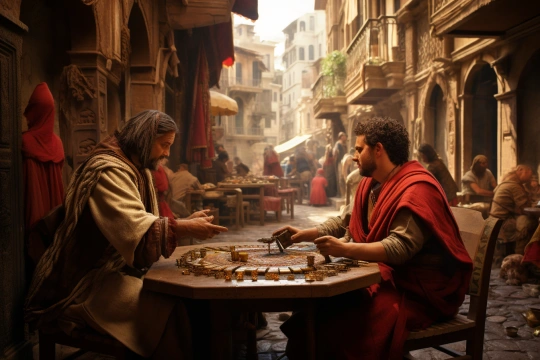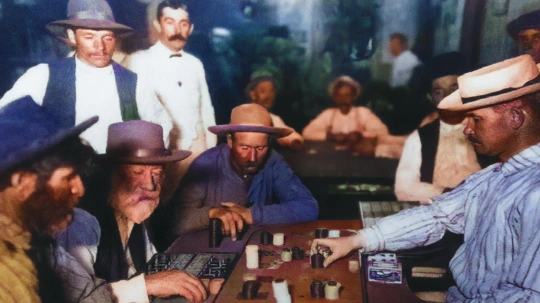Las Vegas – a city that embodies brightness, glamour, and endless possibilities. This unique desert oasis, known for its casinos, shows, and non-stop nightlife, attracts millions of visitors from around the world each year. However, it once was just a small settlement, surrounded by sand and desert. How did this unremarkable town transform into the global capital of entertainment? Let's walk through its history, from its early beginnings to the present day.
The city, which now hosts over 100 casinos and annually attracts more than 40 million tourists, Las Vegas began its journey as a railroad town in the early 20th century. Over the past century, it has transformed into a place where dreams come true, and fairy tales become a reality.
In this article, we will explore how Las Vegas transformed from a dusty railroad town into the glamorous capital of the world of gaming and entertainment, who can be considered the key people in its creation and development, as well as some interesting facts about the city that may surprise even the most devoted fans of Las Vegas. Welcome to a journey through the history of Las Vegas - a city that never sleeps.
Early Beginnings
Las Vegas, translating from Spanish as "The Meadows," was not always the dazzling city we know today. For a long time, it was simply an endless desert, covered with shrubs and sand. But even in such harsh conditions, this area was not devoid of life.
The geological history of the Las Vegas valley begins millions of years ago when the area was covered by water. Over time, the water receded, leaving behind fertile soils and extensive natural water sources, creating ideal conditions for life in this otherwise dry and lifeless desert.
The first inhabitants of these places were various Native American tribes. They lived in this area several thousand years ago, hunting, fishing, and gathering fruits. They left behind a rich cultural heritage, including rock paintings, tools, and decorations.
After the arrival of Europeans in the 16th century, this area became part of the New Spanish Kingdom. Spanish missionaries and explorers were the first Europeans to visit this area, but they did not establish permanent settlements here. This would only change in the 19th century when Mormons from Utah attempted to create a permanent settlement in this region. These early attempts, however, did not last long and were abandoned shortly after their creation.
So, the beginning of the history of Las Vegas was far from its modern image of a dream city. But all this changed dramatically with the arrival of the railroad in the early 20th century. This pivotal moment in the city's history paved the way for its incredible transformation and marked the starting point in its journey to the status of the world capital of entertainment.
Founding of Las Vegas
In the early 20th century, when railroad magnates were looking for new routes for their lines across the west, Las Vegas became a key point on the way to Southern California. In 1905, Senator William Clark from Montana purchased land in this region and founded the city of Las Vegas to serve as a station for his railroad line "San Pedro, Los Angeles & Salt Lake Railroad". This moment in the history of Las Vegas would subsequently become a reference point for its rapid growth and development.
Railroad traffic led to the rapid population of the city. Soon, hotels, restaurants, and shops began to be built all over the city to serve arriving passengers and new residents. In 1911, Las Vegas gained city status, and its population continued to grow.
An important moment in the city's history was the opening of the Hoover Dam in 1935, which attracted thousands of workers to the area and contributed to the city's further growth. The dam not only provided an important source of water and electricity for the rapidly developing city but also became a significant landmark, attracting tourists from all over the world.
During these years, Las Vegas was still far from the city we know it today, but the foundations of its future as a global entertainment center were already laid. With the arrival of the railroad and the opening of the Hoover Dam, Las Vegas was ready for the next chapter in its history - the era of underground casinos and the rise of the gambling business.
The Era of Underground Casinos
The Emergence of the Gambling Business
In 1931, amid the Great Depression, the state of Nevada legalized gambling. While this was done to stimulate the economy, Las Vegas, a small town with a modest population, was not yet ready for the arrival of the gambling business. This changed with the onset of Prohibition.
Prohibition, the ban on the production and sale of alcohol in the United States, came into effect in 1920. Although its aim was to improve public health and morality, in practice it led to an increase in organized crime. Underground bars, or "speakeasies," began to appear across the country, including Las Vegas. These illegal establishments offered customers not only prohibited alcohol but also gambling.
Influence of Organized Crime
Prohibition led to an increase in the influence of organized crime in Las Vegas. Mafia families from Chicago and other cities saw the city as an opportunity to expand their operations. They began investing in underground gambling houses and bars, providing gambling and entertainment for tourists and locals.
This era had a significant impact on the development of Las Vegas as the "capital of the world gambling business". It laid the foundation for the city's gambling industry and prepared the ground for its future transformation into a global entertainment capital.
However, with the rise of mafia influence came problems. Corruption, violence, and crime became widespread. But despite these challenges, Las Vegas began to attract attention as a place where you could "roll the dice" and try your luck.
Transformation into the Entertainment Capital
Construction of the First Casinos
After the legalization of gambling in 1931, Las Vegas gradually began to transform from a small town into the country's main gambling destination. However, the real breakthrough came after World War II, when the first casinos began to be built in the city.
One of the first such establishments was the Flamingo casino, opened in 1946. Its creator was Bugsy Siegel, a notorious gangster and member of Meyer Lansky's family. The casino was the first of its kind - a luxurious gambling hall offering not only gambling but also shows, premium service, and many other forms of entertainment.
Contribution of Moe Sedway, Bugsy Siegel, and Other Key Figures
Many key figures of this time made a significant contribution to the transformation of Las Vegas. In addition to Siegel, Moe Sedway, another notorious gangster and a member of the Chicago mafia family, also invested in the city. He took part in several projects, including the Desert Inn hotel, which became one of the most luxurious and famous casinos in Las Vegas.
These and other key figures helped shape the image of Las Vegas as a place where you could not only try your luck at gambling but also enjoy high-quality entertainment and services. Their contribution was not limited to just building gambling establishments - they also attracted celebrities and held lavish parties, which attracted the attention of the press and made Las Vegas known to the whole world.
In the next chapter, we will look at how nuclear tests became an unexpected source of tourism in the 1950s, and how Las Vegas used this to its advantage.
Las Vegas and Atomic Tourism
Atomic Testing
In the 1950s, Las Vegas became the site of an unusual tourist attraction - observing atomic testing. At this time, the United States was in an arms race, and atomic testing became a common occurrence. The test site, located 65 miles northwest of Las Vegas, was one of the main places where these tests were conducted.
Atomic Tourism
While watching the explosions of nuclear weapons might seem like a strange entertainment, it became a reality in Las Vegas. The city used these tests as a marketing ploy, attracting tourists with the promise of the opportunity to watch atomic explosions from a safe distance.
Hotels in Las Vegas organized "explosion parties," offering visitors places on rooftops to watch the bright light and mushroom cloud of the explosion. This "atomic tourism" became so popular that the city even earned the nickname "Atomic City".
Influence on Las Vegas' Fame
Atomic tourism played a crucial role in the development of Las Vegas as a tourist destination. It drew attention to the city and helped to reinforce its reputation as a place for unusual and unique entertainment. Despite its strangeness and potential dangers, this period in Las Vegas' history is an important element of its unique cultural heritage.
In the next chapter, we will look at how Las Vegas continued its development in the 1960s and 1970s, including the rise and fall of the Rat Pack, the growth of corporate influence, and its effects on the city.
The Light of a Million Lights: Las Vegas Today

Las Vegas is undoubtedly one of the brightest cities in the world. Just the famous 4.2-mile-long "Strip" is known for its numerous neon signs, endless rows of lamps, and astonishing light shows. In fact, Las Vegas uses over 12,427 miles of LED lamps on its famous "Strip," creating an incredible spectacle that can even be seen from space.
Today, there are over 100 casinos in Las Vegas, each striving to attract visitors with its unique atmosphere and variety of games. From opulent and luxurious casinos like Bellagio and Venetian to more historical establishments like Golden Nugget, the choice is endless.
But Las Vegas is not just about casinos. The city is also known for its shows, world-class restaurants, boutiques of famous brands, as well as unique attractions such as the High Roller, the largest observation wheel in the world, and the Stratosphere Tower, which offers a stunning view of the city.
Las Vegas is rightly considered one of the most visited cities in the world. In 2019, the city attracted more than 49.5 million visitors. Even though the COVID-19 pandemic has hit the tourism industry worldwide, Las Vegas continues to remain on the list of the most popular tourist destinations.
Much of Las Vegas' success is due to its ability to constantly refresh and adapt to offer visitors something new. The city continues to evolve and recover, attracting tourists from all over the world with its glitter, glamour, and promise of endless entertainment.
Las Vegas in Pop Culture
Las Vegas and Hollywood
Las Vegas has been and remains a popular location for Hollywood film shoots. In cinema, Las Vegas is often represented as a symbol of the American dream, a city where anything is possible. Among the most famous films shot in Las Vegas are "Ocean's Eleven," "The Passion of the Christ," "Fear and Loathing in Las Vegas," and "The Hangover".
Las Vegas Music Scene
Las Vegas is also a significant center of musical culture. Elvis Presley, Frank Sinatra, Celine Dion, Britney Spears, and many other stars held their residencies in the city. Many of them dedicated songs to Las Vegas, including Elvis Presley's "Viva Las Vegas" and Frank Sinatra's "Luck Be a Lady".
Las Vegas in Literature
In literature, Las Vegas is often used as a metaphor for American consumerism and freedom. One of the most famous examples is Hunter S. Thompson's novel "Fear and Loathing in Las Vegas," in which the author describes his crazy journey through the city.
Las Vegas in Video Games
Las Vegas has also become an important element in the world of video games. In the game "Fallout: New Vegas," players can explore a post-apocalyptic version of the city, and in the "Grand Theft Auto" game series, Las Vegas serves as the inspiration for the fictional city of Las Venturas.
Conclusion
Las Vegas is a city that has truly transformed itself 'from dust to dazzle'. It has journeyed an incredible path from being a small settlement in the desert to one of the most vibrant and thrilling cities in the world, literally glowing with millions of lights. With its dazzling neon displays, multitude of entertainments, and constant energy, Las Vegas leaves an indelible impression on everyone who visits.
Today, Las Vegas is famous for its casinos, but the city's history is much deeper and more complex than it might seem at first glance. From early Spanish explorers to the era of underground casinos, from atomic tourism to its current status as a global entertainment capital - Las Vegas has constantly evolved, changed, and adapted to new realities.
A city that has rightfully earned its reputation as a place where you can 'win millions or lose it all' continues to attract people from all over the world with its promises of wealth, luck, and endless entertainment. And, despite all obstacles, Las Vegas continues to shine brighter than ever, using over 20,000 kilometers of LED lamps on its famous 'Strip'.
Las Vegas has many challenges ahead, including the need for more sustainable development and tackling climate change. But if history has shown anything, it's that Las Vegas is always ready to meet these challenges and transform in order to continue crafting its unique story in the heart of the desert.





